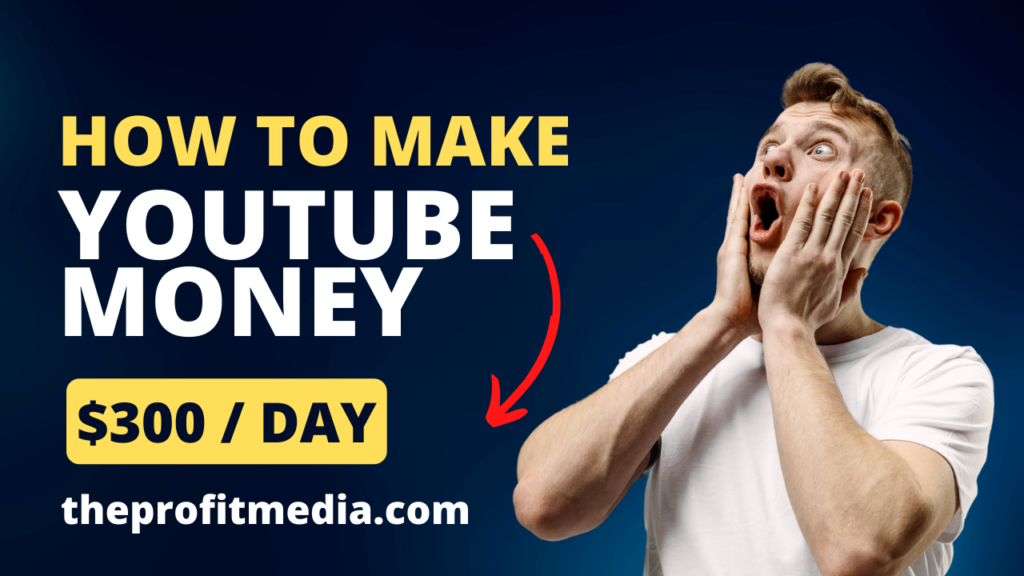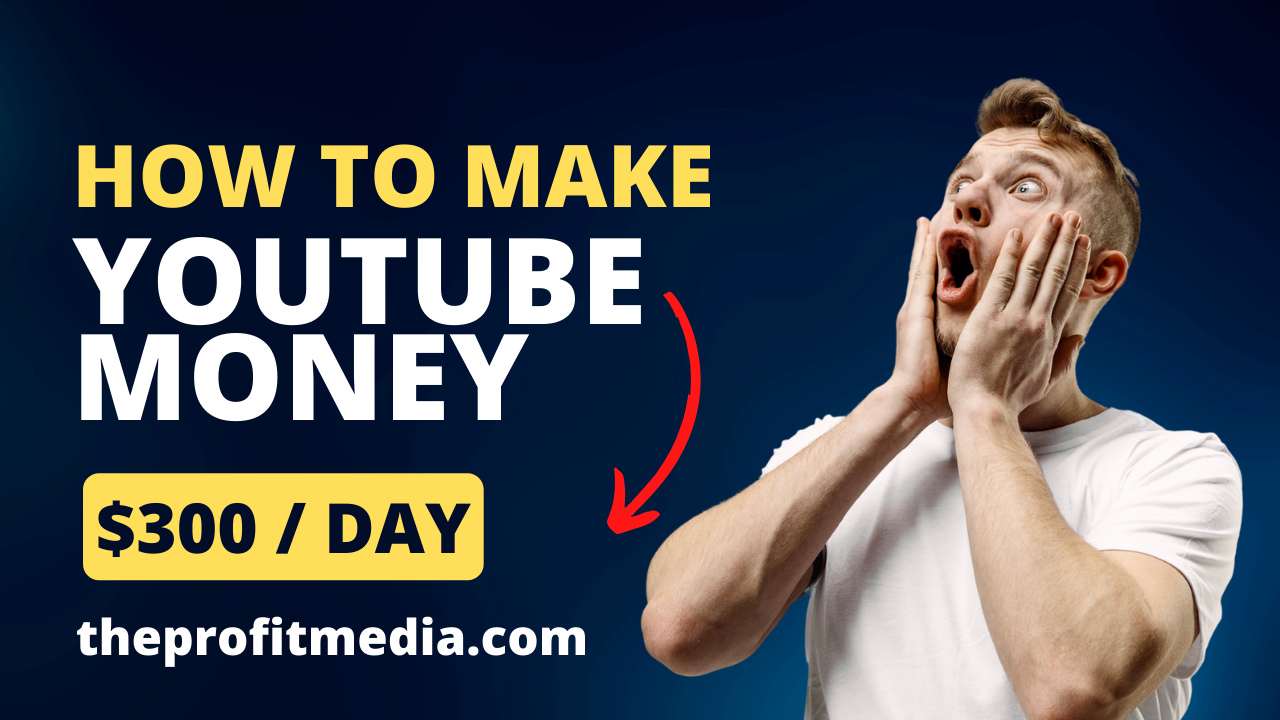YouTube has become a powerful platform for content creators to share their passion and expertise while also making a living. But what if you don’t want to create your own videos? Is it possible to make money on YouTube without producing original content? The answer is yes, and in this step-by-step guide, we’ll explore how you can achieve this.
Proven Way to Make $997 Every Time – Watch this FREE Video to START

Step 1: Choose Your Niche
Identify a Profitable Niche: Start by selecting a niche that has a substantial audience and offers monetization opportunities. Popular niches include product reviews, educational content, entertainment, and lifestyle topics.
Step 2: Research and Create a Strategy
1. Market Research: Conduct in-depth research to understand the competition, target audience, and trending content within your chosen niche. Tools like Google Trends and YouTube Analytics are valuable for data gathering.
2. Content Strategy: Develop a content strategy that outlines the types of videos you plan to feature on your channel. These could include product reviews, tutorials, compilations, or themed collections.
Step 3: Create a YouTube Channel
1. Set Up a YouTube Channel: If you don’t already have one, create a YouTube channel. Choose a name that reflects your niche and is both descriptive and memorable.
2. Channel Branding: Customize your channel’s profile picture, cover image, and description to make it appealing and relevant to your chosen niche.
Step 4: Curate Existing Content
1. Find Existing Videos: Search YouTube for publicly available videos with Creative Commons licenses or from content creators who permit the reuse of their content.
2. Video Compilation: Create compilations, playlists, or themed collections of existing videos within your niche. For example, if your niche is “tech reviews,” compile various product reviews into playlists.
Step 5: Add Value and Monetize
1. Provide Value: Even when curating existing content, it’s crucial to add value to your audience. Consider providing commentary, insights, or context to enhance the viewing experience and differentiate your channel.
2. Monetization Methods:
– Affiliate Marketing: Promote products or services related to your niche and include affiliate links in your video descriptions. Earn a commission for sales generated through your links.
– Ad Revenue: As your channel grows and meets YouTube’s monetization requirements, you can earn revenue through ads displayed on your videos.
– Sponsorships: Attract sponsorships from companies seeking to reach your niche’s audience and promote their products or services in your videos.
Proven Way to Make $997 Every Time – Watch this FREE Video to START
Step 6: Optimize Your Channel
1. SEO Optimization: To improve search visibility, optimize your video titles, descriptions, and tags with relevant keywords used by your niche’s audience.
2. Engage with Your Audience: Interact with your viewers by responding to comments and encouraging them to subscribe, like, and share your content.
Step 7: Promote Your Channel
1. Leverage Social Media: Share your videos and channel on other social media platforms to increase visibility and attract more subscribers.
Step 8: Track and Analyze Performance
1. Analyze Performance: Regularly review YouTube Analytics to assess the performance of your videos and channel. This data will guide you in refining your strategy.
Step 9: Stay Consistent and Persistent
1. Consistency: Maintain a consistent posting schedule to keep your audience engaged and returning for more. The more content you create, the greater your opportunities for income.
Step 10: Comply with Copyright and Community Guidelines
1. Copyright Rules: Ensure that you’re adhering to YouTube’s copyright policies. Use only videos with proper permissions, Creative Commons licenses, or from creators who allow content reuse.
2. Community Guidelines: Adhere to YouTube’s community guidelines to avoid content removal or channel suspension.
Proven Way to Make $997 Every Time – Watch this FREE Video to START
Step 1: Choose Your Niche
Selecting the right niche for your YouTube channel is a critical step, even if you’re not producing your own videos. While you might not be behind the camera, your niche determines the type of content you’ll curate and the interests of your audience. In this guide, we’ll explore how to choose the perfect niche for making money on YouTube without creating videos.
1. Identify Your Audience:
Determine the audience you want to target with your curated content. Consider their demographics, interests, and preferences. This will help you tailor your niche to meet the needs and expectations of your viewers.
2. Align with Your Affiliate Products:
If you plan to monetize through affiliate marketing, align your niche with the products or services you intend to promote. For example, if you’re an affiliate for tech products, a niche related to technology reviews or tutorials might be a good fit.
3. Consider High-Interest Topics:
Look for niches that have a broad appeal and high search volume on YouTube. Topics like product reviews, tutorials, and lifestyle often perform well. These niches attract a diverse range of viewers, increasing your potential audience.
4. Analyze Competitor Channels:
Examine other YouTube channels in your chosen niche, particularly those curating existing content. Assess their subscriber count, view counts, and engagement. Analyzing competitor channels can give you insights into the niches that are more likely to attract viewers and subscribers.
5. Evaluate Trends and Seasonality:
Consider the trends and seasonality of your chosen niche. Some niches have consistent year-round interest, while others may experience spikes during specific seasons or trends. Understanding these patterns can help you plan content for optimal reach and engagement.
Step 2: Research and Create a Strategy
When venturing into the world of YouTube without creating your own videos, research and strategy become your guiding stars. These elements are crucial to your success as you curate and promote existing content. In this guide, we’ll explore the process of researching and crafting a strategy that will help you thrive on YouTube.
1. Understand Your Audience:
Before you can curate content effectively, you need to understand your target audience. Who are they? What are their interests, pain points, and preferences? Use tools like YouTube Analytics and social media insights to gain a deep understanding of your audience’s demographics and behavior.
2. Niche Research:
Conduct thorough research on your chosen niche. Analyze the top channels and videos in your niche to understand what content performs well and why. Identify gaps or areas where you can add unique value.
3. Content Curation Strategy:
Outline your content curation strategy. What types of videos will you compile or feature on your channel? Will you create themed playlists, compilations, or guides? Determine how you’ll organize your curated content to make it accessible and engaging for your audience.
4. Competitor Analysis:
Study competitor channels that curate content in a similar niche. Examine their content quality, presentation, and engagement tactics. Understand what makes them successful and how you can differentiate your channel.
5. SEO and Keyword Research:
Optimize your content for search engines and YouTube’s algorithms. Perform keyword research to identify high-traffic, relevant keywords and phrases in your niche. Use these keywords strategically in your video titles, descriptions, and tags.
6. Promotion and Engagement:
Craft a strategy for promoting your YouTube channel and engaging with your audience. Leverage social media platforms, forums, and online communities to share your curated content. Encourage discussions, respond to comments, and build a sense of community around your channel.
7. Consistency and Posting Schedule:
Decide on a consistent posting schedule. Whether it’s daily, weekly, or monthly, consistency is vital for retaining and growing your audience. Stick to your schedule to build anticipation and trust.
8. Track and Analyze Performance:
Regularly review your channel’s performance using YouTube Analytics. Pay attention to metrics like views, watch time, and subscriber growth. Analyze which content performs best and adjust your strategy accordingly.
9. Adapt and Evolve:
Stay flexible and open to adaptation. As trends change and your channel matures, be ready to refine your strategy. Your initial approach may need adjustments to maximize your success.
Research and strategy are the cornerstones of building a successful YouTube channel without creating your own videos. They help you understand your audience, curate content effectively, and optimize for visibility and engagement. By consistently implementing your strategy, staying attuned to analytics, and adapting when necessary, you can create a thriving channel that attracts subscribers, keeps viewers engaged, and, ultimately, helps you achieve your YouTube success.
Proven Way to Make $997 Every Time – Watch this FREE Video to START
Step 3: Create a YouTube Channel
When your goal is to make money on YouTube without creating your own videos, the process begins with creating a YouTube channel. This channel serves as the foundation for your content curation and affiliate marketing efforts. In this guide, we’ll explore the steps to create a YouTube channel for your curated content journey.
1. Sign in to Your Google Account:
To create a YouTube channel, you’ll need to sign in with your Google account. If you don’t have one, you can create a new account.
2. Access YouTube Studio:
Once signed in, click on your profile picture in the top right corner of the YouTube homepage. From the dropdown menu, select “YouTube Studio.”
3. Go to the “Settings” Section:
Within YouTube Studio, navigate to the “Settings” section. You can find this on the left-hand menu under the gear icon.
4. Click on “Channel” and “Advanced Settings”:
Under “Settings,” select “Channel” and then click “Advanced settings.”
5. Create Your Channel:
In the “Advanced settings” section, click the “Create Channel” button. You’ll be prompted to choose a name for your channel. This can be a custom name or a name based on your niche.
6. Customize Your Channel:
After creating your channel, you can customize it further. Add a profile picture and a cover image that reflect your niche or branding. Write a channel description that introduces your content and what viewers can expect.
7. Add Links and Contact Information:
Under the “Customize channel” section, you can add links to your social media profiles, websites, or affiliate product pages. Ensure that your audience can easily connect with you outside of YouTube.
8. Enable Monetization:
If you plan to monetize your YouTube channel through ads or other means, you’ll need to enable monetization in the YouTube Studio settings.
9. Organize Your Content:
Before you start curating and featuring videos, consider organizing your channel by creating playlists. Group related content together to make it easier for your audience to navigate.
10. Configure Privacy Settings:
Depending on your content strategy, you may want to configure privacy settings for your channel and videos. Some content may be set as unlisted or private, while others remain public.
11. Promote Your Channel:
Once your channel is set up, begin promoting it on other social media platforms, websites, and online communities. Encourage your target audience to subscribe to your channel.
Creating your YouTube channel is the first step on your journey to making money on YouTube without creating your own videos. Your channel serves as the hub for curating and organizing content, as well as a platform for affiliate marketing. Customize it to reflect your niche, enable monetization, and don’t forget to promote your channel to attract subscribers and viewers. With a well-organized channel, you’re ready to start curating content and building your online presence.
Step 4: Curate Existing Content
Curating existing content is at the heart of making money on YouTube without producing your videos. This strategic approach involves selecting, organizing, and adding value to videos created by other content creators. In this guide, we’ll explore how to curate existing content effectively on your YouTube channel.
1. Identify Your Curated Content:
The first step is to identify the videos you want to curate on your channel. These can be videos that align with your niche and resonate with your target audience. Look for high-quality, informative, or entertaining content that viewers will appreciate.
2. Obtain Permissions:
It’s crucial to respect copyright and intellectual property rights. Ensure that you have proper permissions to use the videos you intend to curate. This can involve reaching out to content creators for permission or selecting videos that are licensed under Creative Commons.
3. Add Value and Context:
Curation is more than just reposting videos. To make your channel stand out, add value to the curated content. Provide your insights, commentary, or context in the video description or through voiceovers. This value addition helps viewers understand why the curated content is worth their time.
4. Organize Playlists and Compilations:
Instead of haphazardly curating content, organize it into playlists, compilations, or themed collections. This makes it easier for viewers to navigate and find content related to their interests.
5. Consistency and Quality:
Maintain a consistent and high standard for the content you curate. Curate content that aligns with your niche and offers viewers a reliable source of information, entertainment, or education.
6. Engage with Your Audience:
Engage with your viewers by responding to comments, encouraging discussions, and building a sense of community around your curated content. Your audience’s engagement can lead to increased subscribers and monetization opportunities.
7. Proper Attribution:
Always provide proper attribution to the original content creators. This can be done in the video description or through credits within the video. Respecting the work of others is essential for ethical curation.
8. Content Diversity:
Diversify your curated content to appeal to a broader audience. Offer a range of videos that cater to different interests within your niche.
9. Monitor and Update:
Regularly monitor the performance of your curated content. Pay attention to which videos resonate with your audience and adjust your curation strategy accordingly. Update your playlists and compilations to keep content fresh and relevant.
Step 5: Add Value and Monetize
Curating content on your YouTube channel is not only about sharing other creators’ videos; it’s also about adding value and monetizing your efforts. In this guide, we’ll explore five essential ways to add value to your curated content and turn it into a source of income.
1. Provide Context and Commentary:
– To distinguish your channel and provide value, offer context or commentary for the curated videos. Share your insights, additional information, or your perspective on why the video is worth watching. This added layer of content can make your channel more informative and engaging.
2. Curate Themed Playlists:
– Organize curated videos into themed playlists. Group related videos together to help viewers find content that interests them. Curated playlists make navigation easier and encourage viewers to spend more time on your channel.
3. Promote Affiliate Products:
– One of the primary monetization methods for a curated content channel is affiliate marketing. Select products or services related to your niche and feature them in the video descriptions. Include affiliate links, and earn a commission for any sales generated through those links.
4. Enable Ads on Your Videos:
– Once your channel meets YouTube’s monetization requirements (1,000 subscribers and 4,000 watch hours in the past 12 months), you can enable ads on your videos. YouTube will display ads, and you’ll earn revenue based on ad views, clicks, and engagement.
5. Attract Sponsorships:
– As your channel grows in popularity and gains a substantial audience, consider attracting sponsorships from companies interested in reaching your niche’s audience. Collaborate with sponsors to promote their products or services in your curated videos and earn fees or commissions.
Proven Way to Make $997 Every Time – Watch this FREE Video to START
Step 6: Optimize Your Channel
Optimizing your YouTube channel is essential for attracting viewers, retaining subscribers, and ensuring your curated content reaches its full potential. In this guide, we’ll explore five key steps to optimize your channel and make the most of your curated content efforts.
1. SEO Optimization:
– Just like creating original content, SEO (Search Engine Optimization) is crucial for curated content. Optimize your video titles, descriptions, and tags with relevant keywords and phrases related to your niche. This helps your videos appear in search results and recommendations.
2. Engaging Thumbnails and Channel Art:
– Design eye-catching thumbnails for your videos. Thumbnails are the first impression viewers have of your content. They should be visually appealing and provide a glimpse of what the video offers. Additionally, customize your channel art to reflect your niche and brand.
3. Clear Channel Description:
– Write a clear and concise channel description that introduces your niche and what viewers can expect from your content. Use relevant keywords to enhance discoverability.
4. Playlists and Organization:
– Organize your curated content into playlists. Create playlists for different topics within your niche. This not only helps viewers find content they’re interested in but also keeps them engaged longer on your channel.
5. Regular Posting Schedule:
– Consistency is key on YouTube. Maintain a regular posting schedule to keep viewers coming back for more. When your audience knows when to expect new content, it builds anticipation and trust.
6. Interact with Your Audience:
– Actively engage with your viewers by responding to comments and encouraging discussions. This fosters a sense of community and encourages viewers to subscribe and interact with your channel.
7. Monitor Analytics:
– Regularly review YouTube Analytics to assess the performance of your videos and your channel. Pay attention to metrics like views, watch time, and subscriber growth. Use this data to refine your content strategy.
8. Stay Informed and Adapt:
– YouTube and social media trends evolve continuously. Stay informed about changes, new features, and algorithm updates. Adapt to these changes to ensure your channel remains relevant.
Optimizing your YouTube channel is crucial for the success of your curated content. SEO optimization, engaging thumbnails, clear channel descriptions, organization, and a regular posting schedule are essential elements. Interacting with your audience, monitoring analytics, and staying informed about trends are equally important. By following these steps, you can create a well-optimized channel that attracts and retains viewers, helps you generate income, and establishes your presence on YouTube.
Step 7: Promote Your Channel
Promoting your YouTube channel is a vital step to ensure that your curated content reaches a broader audience and attracts more viewers. In this guide, we’ll explore five effective strategies to promote your channel and maximize the visibility of your curated content.
1. Leverage Social Media:
– Share your curated content on various social media platforms, such as Facebook, Twitter, Instagram, and LinkedIn. Create engaging posts and utilize relevant hashtags to reach a wider audience. Encourage your followers to subscribe to your channel.
2. Collaborate with Content Creators:
– Collaborate with other content creators within your niche or related niches. Partnering with creators for shout-outs, guest appearances, or joint projects can introduce your channel to their viewers, expanding your reach.
3. Engage with Online Communities:
– Participate in online forums, discussion boards, and Reddit communities relevant to your niche. Provide valuable insights and solutions, and discreetly share links to your curated content when it’s genuinely helpful to the discussion.
4. Email Marketing:
– Utilize email marketing to reach out to your existing audience or subscribers. Send regular newsletters with links to your latest curated content, providing an easy way for your audience to access your videos.
5. Cross-Promote Your Videos:
– Within your own curated content, cross-promote other videos in your channel by mentioning them and adding end screens with clickable links. This encourages viewers to explore more of your content.
6. Paid Promotion:
– Consider investing in paid promotions, such as Google Ads or social media advertising, to target specific demographics and reach a wider audience. Paid promotions can be particularly useful in the early stages of channel growth.
7. Engage with Your Audience:
– Respond to comments and engage with your viewers. Encourage them to like, share, and subscribe. An engaged audience is more likely to promote your channel by word of mouth.
8. Attend Industry Events:
– If possible, attend industry events, conventions, or conferences related to your niche. These events provide opportunities to network with potential viewers and fellow content creators.
Step 8: Track and Analyze Performance
Tracking and analyzing the performance of your YouTube channel is crucial for understanding what’s working and where you can improve. In this guide, we’ll explore five key steps for effectively tracking and analyzing your channel’s performance to drive growth and success.
1. Regularly Review YouTube Analytics:
– YouTube provides a wealth of data through its Analytics feature. Regularly review key metrics such as views, watch time, likes, comments, and subscriber growth. Identify which videos perform well and which may need improvement.
2. Audience Insights:
– Dive into the Audience tab in YouTube Analytics to gain a deeper understanding of your viewers. Analyze demographics, location, and viewer behavior. Use this information to tailor your content to your audience’s preferences.
3. Content Performance:
– Analyze the performance of individual videos. Look for patterns and trends. Identify topics or types of content that resonate most with your audience. Create more of what works and adjust or eliminate content that doesn’t perform well.
4. Click-Through Rate (CTR) and Viewer Retention:
– Pay attention to your video’s CTR and viewer retention rates. High CTR indicates your video titles and thumbnails are compelling. High viewer retention means your content keeps viewers engaged. Adjust your titles and thumbnails to improve CTR, and analyze content to retain viewers.
5. SEO Performance:
– Review the performance of your video SEO efforts. Examine which keywords are driving traffic to your videos. Make adjustments to improve the discoverability of your content by focusing on the keywords that perform best.
6. Engagement and Interaction:
– Monitor comments, likes, and shares. Engage with your audience by responding to comments and encouraging discussion. A highly engaged audience is more likely to promote your channel through word of mouth.
7. Conversion Metrics:
– If you’re monetizing through affiliate marketing, track conversion metrics. Analyze which videos generate the most affiliate sales and adjust your content strategy accordingly.
8. Set Goals and Adjust Strategies:
– Based on the data you gather, set clear goals for your channel’s growth. Use the insights to adjust your content strategy, posting schedule, and promotion efforts. Continuously optimize your approach to align with your goals.
Tracking and analyzing your channel’s performance on YouTube is a data-driven approach to growth and success. By regularly reviewing analytics, understanding your audience, and analyzing the performance of your content, you can make informed decisions to improve your channel. Focus on engagement, CTR, viewer retention, and conversion metrics to create a well-rounded strategy. This data-driven approach empowers you to optimize your content, grow your channel, and achieve your goals on YouTube.
Proven Way to Make $997 Every Time – Watch this FREE Video to START
Step 9: Stay Consistent and Persistent
Achieving success on YouTube, especially when curating content, requires unwavering consistency and persistence. In this guide, we’ll explore five crucial points that emphasize the importance of staying the course on your journey to YouTube success.
1. Maintain a Regular Posting Schedule:
– Consistency begins with a regular posting schedule. Whether you post daily, weekly, or on some other schedule, stick to it. Viewers are more likely to subscribe and return to your channel when they know when to expect new content.
2. Persevere Through Challenges:
– YouTube, like any creative endeavor, comes with challenges. You might face fluctuations in views, algorithm changes, or content issues. It’s crucial to persevere through these challenges, adapt your strategy, and keep moving forward.
3. Focus on Audience Building:
– Building an audience takes time and effort. Be patient and persistent in engaging with your audience, responding to comments, and fostering a sense of community. An active and engaged audience can be your most valuable asset.
4. Learn from Analytics:
– Regularly review YouTube Analytics to understand what’s working and what’s not. Use this data to refine your content strategy. Consistency means not only in your posting schedule but also in your dedication to improvement.
5. Set Realistic Goals:
– Set achievable and measurable goals for your channel. Consistently work toward these goals while recognizing that growth might be gradual. Celebrate small milestones along the way to stay motivated.
Staying consistent and persistent on your YouTube journey is the key to long-term success. Maintaining a regular posting schedule, persevering through challenges, focusing on audience building, learning from analytics, and setting realistic goals are the cornerstones of your dedication.
Step 10: Comply with Copyright and Community Guidelines
Ensuring that you comply with copyright and community guidelines on YouTube is not only an ethical responsibility but also crucial for maintaining the integrity and success of your channel. In this guide, we’ll explore five essential points to help you navigate the ethical and legal aspects of content curation on the platform.
1. Respect Copyright Laws:
– When curating content, it’s vital to respect copyright laws. Only use content for which you have proper permissions or that is licensed under Creative Commons. Using copyrighted material without permission can result in copyright strikes, demonetization, or even channel termination.
2. Attribute and Credit Properly:
– Whenever you use content created by others, provide proper attribution and credit to the original creators. This is not only respectful but also a requirement under copyright law. Include credits in video descriptions or within the video itself, as appropriate.
3. Familiarize Yourself with YouTube’s Community Guidelines:
– YouTube has community guidelines that set the standards for content on the platform. Ensure you’re familiar with these guidelines and abide by them. Violations can lead to warnings, restrictions, or channel removal.
4. Monitor and Moderate Comments:
– Regularly monitor and moderate the comments on your videos. Remove or report inappropriate comments, and encourage a positive and respectful community. Promote constructive discussions and report any instances of harassment or harmful behavior.
5. Educate Yourself Continuously:
– Stay updated with changes in copyright laws and YouTube’s policies. Continuous education on these matters will help you avoid accidental violations and protect your channel.
Compliance with copyright and community guidelines is not just a legal obligation but also a commitment to ethical content curation. Respecting copyright laws, attributing content properly, understanding YouTube’s community guidelines, moderating comments, and staying informed are all essential to maintain the integrity of your channel and ensure its long-term success.
Proven Way to Make $997 Every Time – Watch this FREE Video to START
Conclusion:
Making money on YouTube without creating your own videos is a viable strategy, but it requires careful planning, ethical practices, and respect for copyright rules. While it may take time to see significant revenue, patience, and persistence are key to your success in this approach. By carefully curating and adding value to existing content, you can create a valuable channel for your niche, attract an engaged audience, and open up multiple revenue streams on YouTube.











